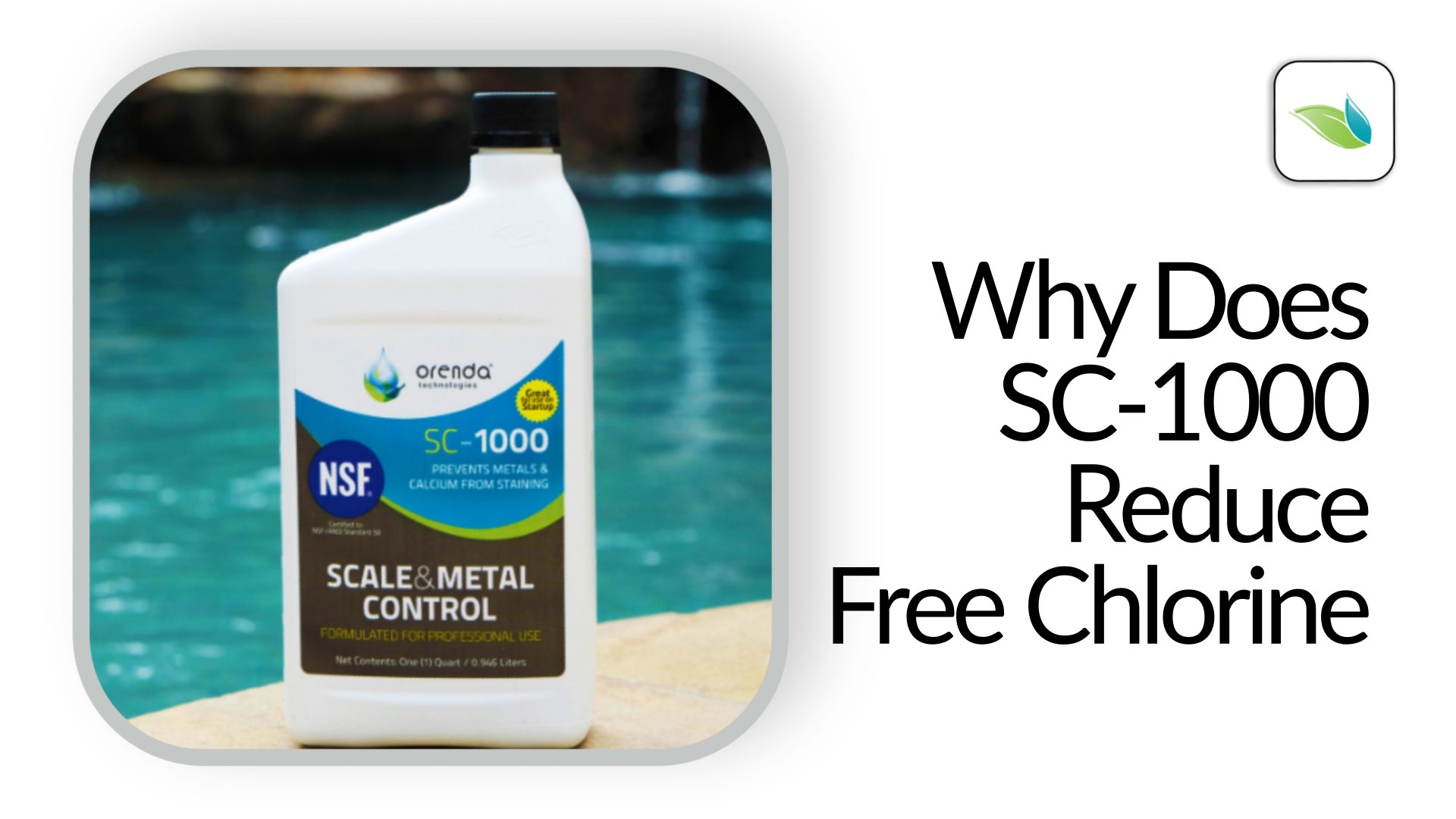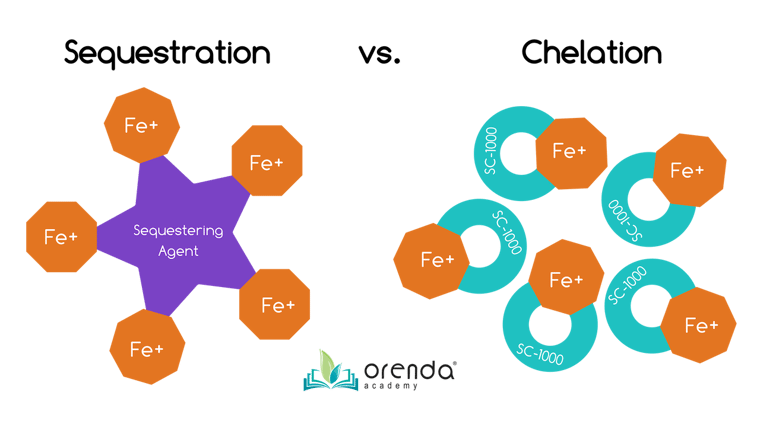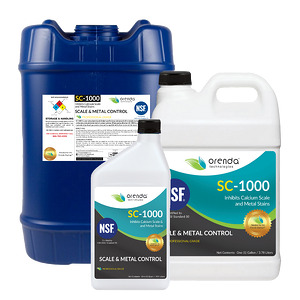Why does SC-1000 reduce free chlorine?

SC-1000, our scale and metal control product, is concentrated and effective. It is arguably our most dynamic product, serving several functions. But for all its benefits, SC-1000 has one major downside––it neutralizes chlorine. This article explains why this happens, and how you can mitigate it.
Covered in this article:
- Chelation vs. Sequestration
- Breakdown of pool sequestering agents
- SC-1000 longevity
- How to minimize chlorine loss with SC-1000
- Conclusion
Chelation vs. Sequestration
First of all, SC-1000 is different from most metal and scale products used in the swimming pool industry. Most other products are sequestering agents, which attract metals and minerals together into a larger molecule. Sequestering prevents oxidation of metals and carbonation of minerals like calcium. Because of this, sequestrants are effective at preventing metal stains and carbonate scale formation.
A sequestering agent is kind of like a magnet that attracts a bunch of metals to it, and holds them in suspension. But SC-1000 is different because SC-1000 is a chelating agent.
Instead of attracting multiple metals and minerals into one larger molecule, a chelating agent like SC-1000 divides and conquers. It individually binds to metals, keeps them separated, and holds them in solution. See our not-at-all-scientific illustration below:

A sequestering agent is good for removing metals––with the help of a metal filter––because it makes the metal particles larger, and therefore easier to filter out. SC-1000 is better for stain and scale prevention because the metals and minerals it binds to are in solution, not just suspension.
Furthermore, SC-1000's strength and longevity far surpass normal sequestering agents...which brings us to our next point.
Breakdown of pool sequestering agents
Most pool sequestering agents are phosphate-based. Most sequestering agents used in drinking water treatment are phosphate-based too, which is why tap water tends to have high levels of phosphates.1,2 Ever since the Flint, Michigan water crisis in 2014, anti-corrosion measures are an EPA requirement.3 Most cities comply with this requirement by using phosphate-based products in the water.
Regardless of how the sequestering agents got in the swimming pool––either by you/your pool service professional or the city drinking water treatment plant––they don't last forever. They break down over time, because chlorine will eventually oxidize them, and sunlight will break them down into orthophosphates.
To be fair to these products, sequestering agents do have decent longevity, provided you use a maintenance dose as recommended on the bottle. That is...unless you use a phosphate remover like PR-10,000. When the sequest is wiped out by PR-10,000, it releases its metals and/or calcium, and suddenly staining and scale are possible again.
This is why we do not manufacture a phosphate-based sequestering agent. The Orenda philosophy has three tenets: proactive pool care, with no chemical conflicts, and no harmful byproducts left behind. Since phosphate-based products always get wiped out by PR-10,000, we needed a stain and scale inhibitor that contains no phosphates. So we have SC-1000.
Related: Orenda Products Overview, and Orenda Product FAQs
SC-1000 longevity
As far as we can tell, SC-1000 has exceptional staying power in the water and shows no sign of being removed by chlorine. The most reliable evidence we have of this is the fact that SC-1000 will deplete free chlorine levels to zero (0 ppm) in a matter of minutes when adding the purge dose.

On a new pool startup, that's no big deal because there is no chlorine yet. SC-1000 has time to bind to calcium and metals before chlorination. It appears SC-1000 is invulnerable to chlorine oxidation entirely. And until it has bound to metals and calcium, chlorine attacks it––and loses.4
That being said, once SC-1000 binds to calcium and metals, chlorine can coexist with it without an issue. Even adding the 3 fl.oz./10,000 gallons/week maintenance dose will not noticeably impact free chlorine levels in the pool.
SC-1000 is also immune to sunlight degradation. And since it contains zero phosphates, a phosphate remover like PR-10,000 is compatible with it. The bottom line: SC-1000's longevity make it a preferred long-term solution for startups and spring openings.
When adding calcium chloride, for instance, you can use SC-1000 at a rate of about 1 fl.oz. per 10 pounds of calcium chloride. This will chelate the calcium and hold it in solution, helping to ensure that new calcium will not become carbonate scale in the future. Of course, the LSI still matters, but SC-1000 provides some grace in higher-LSI water by inhibiting scale formation over the long-term.
How to minimize chlorine loss with SC-1000
.png?width=760&height=428&name=SC-1000%20(1).png)
If SC-1000 wipes out free chlorine, what can be done to hold chlorine levels? Thanks to some of our customers who use SC-1000 regularly, they have devised some clever techniques to mitigate the chlorine loss problem.
Primarily, divide the purge dose up over multiple days. Rather than dumping in the full quart per 10,000-gallon purge dose (32 fl.oz./10,000 gallons), maybe add it over 3, 4, or 5 days. Another option is to divide the purge dose into 11 weeks of weekly doses, and then stop.
(11 weeks) x (3 fl.oz./10,000 gallons per week) = (33 fl.oz / 10,000 gallons)
11 consecutive weekly maintenance doses = one purge dose
Apart from a startup, there are only rare instances where urgency is needed when using SC-1000. If you divide it up, its impact on chlorine is also divided up, and free chlorine can maintain a residual throughout the process.
Another idea is to deliberately not add chlorine for a day or two when purging. Give SC-1000 time to circulate and do its job, then add chlorine. Manually feeding chlorine every day will just waste it if SC-1000 is still trying to work.
Another technique is to wait until the water is warm enough to add it–at least above 60ºF and rising. Almost all water chemistry reactions slow down when the temperature drops and chelation is no different. We do not recommend adding SC-1000 for winterization; instead, we recommend adding it in the springtime.
Again, we need SC-1000 to activate and do its job before chlorine can coexist with it. If the water is warm, it will activate faster, and chlorine will hold sooner. So put it in with dissolving calcium chloride––which creates a heat––to allow SC-1000 to activate faster.
Conclusion
Like any great product, SC-1000 has drawbacks. The main one is chlorine attacks it until it has had time to do its job. This depletes chlorine rapidly, similar to the chlorine-neutralizing product sodium thiosulfate.
While we cannot change this, we can mitigate the chlorine loss by dividing up the purge dose of SC-1000, adding when the water is warm, and giving it enough time to activate before forcing chlorine into the pool.
If you are adding SC-1000 to an open and active pool––like a commercial pool in season––not having chlorine for a few days is not an option. In this case, dividing the SC-1000 dose is essential. Do not add the SC-1000 purge dose to a busy pool that cannot afford a few days of no chlorine. There is no urgency to SC-1000, so take your time and divide it up. Learn more here.
1 Ever since the water crisis in Flint, Michigan in 2014, the EPA and other government agencies have ramped up enforcement of anti-corrosion measures in drinking water treatment. This is a good thing overall, because it helps protect all of us from metal poisoning, and it helps protect the infrastructure of the water grid. Most cities and municipalities treat their drinking water with some sort of phosphate-based sequestering agents to comply with the anti-corrosion regulations. And it's a good thing they do. But phosphates in swimming pools create problems. For more on the Flint, Michigan water crisis, here's a journal article:
Pieper, K., Tang, M., and Edwards, M. (2017). Flint Water Crisis Caused By Interrupted Corrosion Control: Investigating “Ground Zero” Home. Environmental Science & Technology, 51 (4) 2007-2014. https://doi.org/10.1021/acs.est.6b04034
3 US EPA. (2016). Optimal corrosion control treatment evaluation, technical recommendations for primacy agencies and public water systems.
4 As an aside, SC-1000 is biodegradable, which makes it an excellent dechlorination product before disposing of water. It is used in other industries for this exact purpose. If your local health codes require dechlorination before backwashing or draining a pool, consider SC-1000 to quickly neutralize chlorine before dumping water down the drain.
